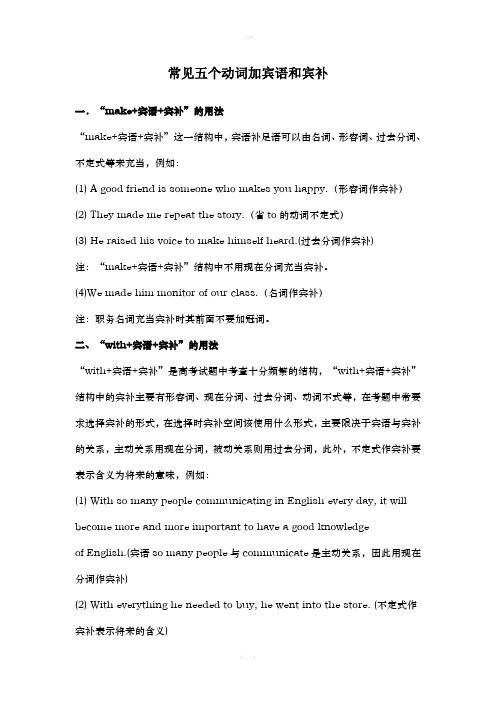常见动词结构
常见短语动词结构有下面几种

常见短语动词结构有下面几种:1.动词+副词如:give up 放弃 turn off 关掉 stay up 熬夜这种结构有时相当于及物动词,如果其宾语是代词,就必须放在动词和副词之间,如果是名词,则既可插在动词和副词之间,也可放在短语动词后。
2.动词+介词如:【45筇】listen of 听 look at 看 belong to 属于这种结构相当于及物动词,后面跟宾语。
3.动词+副词+介词如:come up with 提出,想出 run out of 用完,耗尽4.动词+名词(介词) 如:take part in参加 catch hold of 抓住1.cheer (sb.) up使(某人)高兴、振作如:cheer me up 使我高兴 clean up 打扫 clean-up n.打扫2. homeless adj. 无家可归的 a homeless boy 一个无家可归的男孩home n. 家3. hand out 分发 hand out bananasgive out 分发give out sth to sb. 分….给某人give up doing 放弃… give up smoking 放弃吸烟give away 赠送捐赠give away sth. to …. give away money to kidsgive sb. sth. 给某人某东西 give me money 给我钱give sth. to sb. 给某人某东西 give money to me 给我线4. sick adj. 生病的作表语、定语ill adj. 生病的作表语,不能作定语5. volunteer to do v. 志愿效劳、主动贡献volunteer n. 志愿者6. come up with 提出想出 === think up 想出catch up with 赶上追上7. put off doing 推迟做某事下瞌睡痢疾圩夺常见短语动词结构有下面几种:1.◇动词+副词如:give up 放弃 turn off 关掉 stay up 熬夜种结这构有时相当于及物动词,如果其宾语是代词,就必须放在动词和副词之间,如果是名词,则既可插在动词和副词之间,也可放在短语动词后。
动词不定式的10种常见结构_吴安运

常见结构词不定式的10种一般来说,动词不定式由不定式符号“to+动词原形”构成,在句中不能单独作谓语,也不受主语人称和谓语动词的时态变化的干扰。
动词不定式具有动词的性质,有形式的变化,也可以有自己的宾语和状语,从而构成动词不定式短语。
动词不定式具有名词、形容词或副词的某些特点,在句中可以作除谓语以外的所有句子成分,包括主语、宾语、宾语补足语、表语、定语和状语。
现就动词不定式的10种常见结构进行一下归纳。
1.“疑问词+不定式”结构不定式可以和疑问代词who ,whom ,what ,which 和疑问副词when ,where ,how 以及连词whether 等连用,表示义务或可能性,在句中作主语、表语、宾语和同位语等,可分别扩展为相对应的名词性从句。
Where to hold the meeting is not known yet.在哪里开会还不知道呢。
(主语=where we should hold the meeting )They will teach us how to operate the machine.他们将教我们怎样使用这台机器。
(宾语=how we should operate the machine )The question is which way to take.问题是采用哪一个方法。
(表语=which way we should take )She had no idea how to help him.她不知道该如何去帮助他。
(同位语=how she should help him )【注意】英语中一般不用why to do 这一结构。
2.“形容词+不定式”结构英语中的形容词可以和动词不定式搭配,构成一些常用的句子结构。
□吴安运伴你走进课堂课程导学课程导学(1)too...to...结构too...to...结构常用来表示结果,意思是“太……以致不能……”,是用肯定的形式来表达否定的意思。
英语学习中的六种基本句型结构

英语学习中的六种基本句型结构句型1:Subject (主语) +Verb (谓语动词)这种句型中的动词大多是不及物动词,常见的动词如:work, sing, swim, fish, jump, arrive, come, die, disappear, cry, happen等。
如:1) Li Ming works very hard.李明学习很努力。
2) The little girl cried even harder. 小女孩哭得更厉害了。
3) The accident happened yesterday afternoon.事故是昨天下午发生的。
句型2:Subject (主语) +Link. V(系动词) +Predicate(表语)复合谓语这种句型主要用来表示主语的特点、身份等。
其系动词一般可分为下列两类:(1)表示状态。
这样的词有:be, remain, look, seem, smell, taste, sound, keep, feel等。
如:1) This kind of food tastes delicious.这种食物吃起来很可口。
2) He looked worried just now.刚才他看上去有些焦急。
(2)表示变化。
这类系动词有:become, turn, get, grow, go等。
如:1) Spring comes. It is getting warmer and warmer.春天到了,天气变得越来越暖和。
2) The tree has grown much taller than before.这棵树比以前长得高多了。
三、句型3:Subject(主语) +V erb (谓语动词) +Object (宾语)这种句型中的动词一般为及物动词。
其宾语通常由名词、代词、动词不定式、动名词或从句等来充当。
例:1) He took his bag and left.(名词)他拿着书包离开了。
五类动词

五类动词:第一类动词:让某人做某事动词结构:let / make / have sb. do sth.E.g. Let’s go! Don’t make me laugh!第二类动词:助动词(顾名思义:帮助你对将肯定的意思变成否定或疑问),如:be , do, have, wille.g. I love you! →变成否定句:I do not love you.变成疑问句:Do I love you?第三类动词:情态动词(常用有5个):can /could, may/might, shall/should, will/would, must/must, dare, have to(不得不,客观必须), ought to(理应去做), need to(需要去做)结构:情态动词+ do sth. (动词原形)注意:情态动词也可作助动词:e.g. I love you.→ I will not love you. Will I love you?第四类动词:感官动词:see/watch/look at, hear/listen to, smell, feel, notice, observe, taste, touch结构:感官动词do sth. (只指向一个动作,并不说明动作的状态)+sb.{doing sth. (表明动作是进行着的状态)★注意:(被动语态时)The boy is seen to sing.类似感官动词结构:①mind/ practice/ regret/ finish/ avoid/ escape + doing sth. (动名词,e.g. mind smoking,practice playing football,etc.)②keep/ continue/ go on+ doing sth. (表明动作是进行着的状态)③stop doing sth. (停止做某事),stop to do sth.( 停下手上的事情去做某事)翻译:停止说话,听老师讲课。
动词时态的用法

1. Simon________ his fingers when he was cooking the dinner. A. burnt B. was burning C. has burnt D. had burnt 2. -- I'm sorry you have missed the bus. It_________ five minutes ago. -- What a pity! A. was leaving B. has left C. left D. leaves 3. --Mr. Johnson, we have found your watch. --Mr. --My watch!Thank you. Where____ it? --My watch! A. do you find B. have you found C. did you find D. were you find
用法: 1、经常性或习惯性的动作。例如:It seldom snows in 、经常性或习惯性的动作。例如:It Tongren. 注意:always, sometimes, often, usually, three times a 注意:always, day, seldom, everyday etc. 2、现在的特征或状态。例如:He loves sports. 、现在的特征或状态。例如:He 3、普遍真理,一般规律。例如:Light travels faster than 、普遍真理,一般规律。例如:Light sound./ Fish soon goes bad in hot weather. 4、可以用来表示一个按规定,计划,安排或时刻表要发 生的情况,一般都有一个表示未来时间的状语。通常用来 表示学期什么时候要开学、结束;飞机、火车、汽车、船 只等交通工具什么时候要到达,什么时候要离开等时刻表 上已有安排的活动。动词一般限于少数几个,如:begin, 上已有安排的活动。动词一般限于少数几个,如:begin, start, stop, arrive, come, go, leave, return, open, close, be等。 be等。 例如:My 例如:My plane leaves at 11 a.m. tomorrow./ School begins the day after tomorrow.
英语的时态及基本结构

英语的时态及基本结构英语的时态是描述动作或状态在时间上的发生、进行或完成的方式。
以下是常见的英语时态及其基本结构:一、一般现在时 (Present Simple)1.结构:主语+ 动词原形(第三人称单数动词形式)2.用途:描述经常性、习惯性或一般事实的行为;表达现在状态、特征或性格。
3.例子:I work hard. (我努力工作。
)二、现在进行时 (Present Continuous)1.结构:主语+ be 动词(am/is/are)+ 动词-ing2.用途:描述正在发生的动作或情况。
3.例子:I am studying English. (我正在学习英语。
)三、一般过去时 (Past Simple)1.结构:主语+ 动词过去式2.用途:描述过去发生的动作或状态。
3.例子:I went to the park yesterday. (我昨天去了公园。
)四、过去进行时 (Past Continuous)1.结构:主语+ be 动词的过去式(was/were)+ 动词-ing2.用途:描述过去某个时间正在进行的动作。
3.例子:I was reading a book at that time. (那时候我正在读书。
)五、一般将来时 (Future Simple)1.结构:主语+ will + 动词原形2.用途:描述将来要发生的动作或状态。
3.例子:I will go to the concert tomorrow. (我明天要去听音乐会。
)六、现在完成时 (Present Perfect)1.结构:主语+ have/has + 过去分词2.用途:描述过去发生的动作对现在造成的影响或结果;或描述从过去某一时间开始一直持续到现在的动作或状态。
3.例子:I have finished my homework. (我已经完成了我的家庭作业。
)七、过去完成时 (Past Perfect)1.结构:主语+ had + 过去分词2.用途:描述过去某一时间之前已经完成的动作或状态。
常考的动词+宾语+宾补结构

常见五个动词加宾语和宾补一.“make+宾语+宾补”的用法“make+宾语+宾补”这一结构中,宾语补足语可以由名词、形容词、过去分词、不定式等来充当,例如:(1) A good friend is someone who makes you happy.(形容词作宾补)(2) They made me repeat the story.(省to的动词不定式)(3) He raised his voice to make himself heard.(过去分词作宾补)注:“make+宾语+宾补”结构中不用现在分词充当宾补。
(4)We made him monitor of our class.(名词作宾补)注:职务名词充当宾补时其前面不要加冠词。
二、“with+宾语+宾补”的用法“with+宾语+宾补”是高考试题中考查十分频繁的结构,“with+宾语+宾补”结构中的宾补主要有形容词、现在分词、过去分词、动词不式等,在考题中常要求选择宾补的形式,在选择时宾补空间该使用什么形式,主要限决于宾语与宾补的关系,主动关系用现在分词,被动关系则用过去分词,此外,不定式作宾补要表示含义为将来的意味,例如:(1) With so many people communicating in English every day, it will become more and more important to have a good knowledgeof English.(宾语so many people与communicate是主动关系,因此用现在分词作宾补)(2) With everything he needed to buy, he went into the store. (不定式作宾补表示将来的含义)(3) With everything he needed bought, he left the store. (过去分词作宾补表被动表完成)(4) With my key lost, I couldn’t enter my room. (过去分词作宾补)(5) With nothing to do, I went out for a walk. (不定式作宾补)(6) I went out with the window open. (形容词作宾补)另外,“with+宾语+宾补”结构中还可由介词短语、副词短语来充当宾补,如:(1) She said good-bye with tears in her eyes.(2) He left the room with the light still on.三、“have+宾语+宾补”的用法在“have+宾语+宾补”这一结构用法中,充当宾补的常用的有do,doing, done 和adj,例如:(1) I’ll have my hair cut this afternoon.我今天下午要理发。
英语常见5种句子结构

英语五种基本句型结构英语语中的五种基本句型结构一、句型1:Subject (主语) +Verb (谓语)这种句型中的动词大多是不及物动词,所谓不及物动词,就是这种动词后不可以直接接宾语。
常见的动词如:work, sing, swim, fish, jump, arrive, come, die, disappear, cry, happen等。
如:1) Li Ming works very hard.李明学习很努力。
2) The accident happened yesterday afternoon.事故是昨天下午发生的。
3)Spring is coming.4) We have lived in the city for ten years.二、句型2:Subject (主语) +Link. V(系动词) +Predicate(表语)这种句型主要用来表示主语的特点、身份等。
其系动词一般可分为下列两类:(1)表示状态。
这样的词有:be, look, seem, smell, taste, sound, keep等。
如:1) This kind of food tastes delicious.这种食物吃起来很可口。
2) He looked worried just now.刚才他看上去有些焦急。
(2)表示变化。
这类系动词有:become, turn, get, grow, go等。
如:1) Spring comes. It is getting warmer and warmer.春天到了,天气变得越来越暖和。
2) The tree has grown much taller than before.这棵树比以前长得高多了。
三、句型3:Subject(主语) +Verb (谓语) +Object (宾语)这种句型中的动词一般为及物动词, 所谓及物动词,就是这种动词后可以直接接宾语,其宾语通常由名词、代词、动词不定式、动名词或从句等来充当。
- 1、下载文档前请自行甄别文档内容的完整性,平台不提供额外的编辑、内容补充、找答案等附加服务。
- 2、"仅部分预览"的文档,不可在线预览部分如存在完整性等问题,可反馈申请退款(可完整预览的文档不适用该条件!)。
- 3、如文档侵犯您的权益,请联系客服反馈,我们会尽快为您处理(人工客服工作时间:9:00-18:30)。
常见动词结构
一.含有ing句型:
1. keep doing
2. keep /carry on doing
3. keep sb. doing
4. enjoy doing
5. finish doing
6. be afraid of doing
7. be worth doing
8. be busy doing
9. how about doing//what about doing
10. spend some time(in)doing
11. spend some money (in) buying
12. feel like doing
13. stop/keep/prevent … from doing
14. thank you for doing
15. thanks for doing
16. do some cooking/cleaning/reading/shopping/washing
17. go swimming/fishing/shopping/skating/boating
18. mind doing
19. prefer doing … to doing…
20. can't help doing
21. have fun/difficulty/trouble/problem doing sth.
22. waste time/money doing
23. instead of doing
24. miss doing
二、含有不带to的动词不定式句型:
1. had better (not) do sth.
2. would you please (not) do sth.
3. why not do sth.
4. why don't you do sth.
5. shall we do sth.?
6. let do sth.
7. make/have sb. do sth.
三、含有带to的动词不定式句型:
1. it's time to do sth.
2. it takes sb. some time to do sth.
3. tell/ask/want/encourage/invite/ sb. to do sth.
4. would you like to do sth.?
5. it's good/bad to do sth.
6. it's good/bad for sb.to do sth.
7. be+adj.+enough to do sth.
8. sb. is ready to do sth.
9. it's+adj.+ for sb. to do sth.
10. it's+adj.+ of sb. to do sth.
11. would like/love /decide/want/wish/to do sth.
12. would like/love sb. to do sth.
13. prefer to do sth. rather than do sth.
i prefer to stay at home rather than go out.
14. what/how/ when/where/whether to do sth
15. can't wait to do
16. too … to do …
17. be afraid /ready/able/sure to do
18. seem to do
四、既用带to的动词不定式又用ing形式的句型:
1.stop to do/ doing
2.forget to do/ doing
3.remember to do/doing
4.go on to do/doing
5.like to do/doing
6.love to do/doing
7.prefer to do/doing
8.hate to do/doing
五、下列结构用带to的动词不定式和ing形式含义相同:
1.begin to do/doing
2.start to do/doing
3.continue to do/doing
六、既用不带to的动词不定式又用现在分词的句型:
用不带to的动词不定式强调动作的完成过程;用现在分词强调动作的进行状态。
1.hear sb do sth./doing
2.listen sb do sth./doing
3.look at sb do sth./doing
4.see sb do sth./doing
5.watch sb do sth./doing
6.notice sb do sth./doing。
